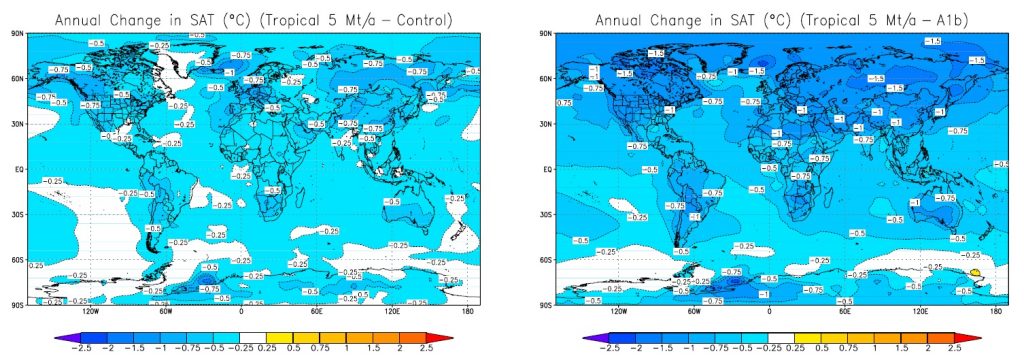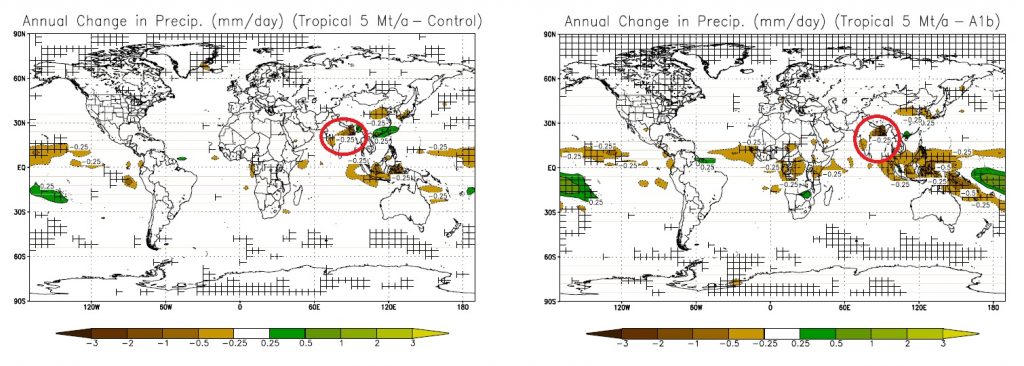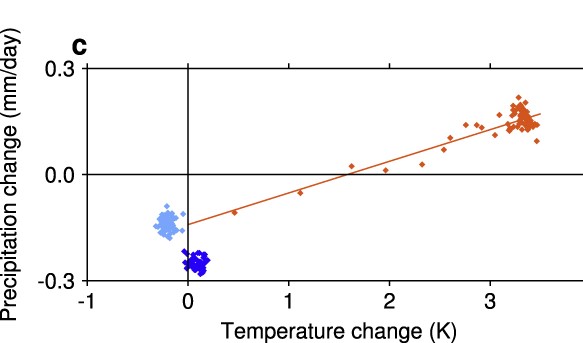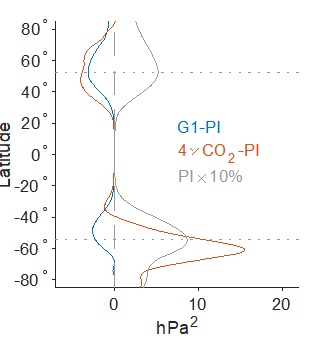The Solar Geoengineering Scientific Discourse Appears Biased
Draft post – do not cite or circulate
A deep dive into how scientists and their universities overemphasize limitations, risks, and potential misuse
When one thinks of bias in scientific research and communication, exaggerated claims likely come to mind. Indeed, scientists sometimes emphasize or even overrepresent their conclusions’ strengths and implications while downplaying uncertainties and contrary evidence.
However, solar geoengineering is different, in that discussions of the science are, if anything, negatively skewed. Evidence from modeling and (to a lesser extent) natural analogues consistently indicates that a judicious use of solar geoengineering — especially by stratospheric aerosol injection — appears capable of reducing climate change effectively, rapidly, inexpensively, reversibly, and imperfectly. Yet the news media, research universities, and scientists themselves disproportionately emphasize and overstate the imperfect: solar geoengineering’s limitations, risks, and potential misuses. Although inaccurate representations in the news media can be partially attributed to the issue’s novelty and complexity, the prospect of scientists and their universities’ communications offices exhibiting a pessimistic bias is peculiar.
To be clear, limitations, risks, and potential misuses are highly important, but they are only part of the story. Taking decision-making seriously necessitates consideration of all relevant advantages and disadvantages. By way of analogy, suppose that an effective coronavirus vaccine were developed. Like all vaccines, it would come with limitations and risks, and could be misused. Suppose further that these downsides were greater than for a typical medicine; for example, maybe failing to complete the series of doses could actually induce COVID. In such a case, what should scientific and news articles emphasize? I suspect that most readers would expect a level-headed depiction of the evidence for its effectiveness and negative aspects, known and potential. I posit that the same should be true of responses to climate change. However, solar geoengineering seems to be held to a higher standard.
Claims of bias are easy to make and difficult to demonstrate. To make my case, I must go somewhat “deep into the weeds.” Below are seven examples where scientists and their universities’ media offices emphasize limitations, risks, and potential misuse while the given evidence overall shows solar geoengineering’s potential efficacy. That is, they bury the lede. The popular media often then (understandably) repeats or even amplifies this tone. In contrast, I am aware of no instances in which scientists or universities overemphasized a scientific paper’s evidence of solar geoengineering’s effectiveness, speed, cost, or reversibility and/or clearly downplayed its drawbacks. If you are aware of any other (counter)examples, please let me know.
Given the length of the evidence below, I put my concluding comments here. If my observations are correct, why do some scientists and universities overemphasize solar geoengineering’s drawbacks? I believe that many scientists — even those who study it — are averse to solar geoengineering, while the rest are unenthusiastic at best. (“Only fools find joy in the prospect of climate engineering,” as Ken Caldeira put it.) In addition, my guess is that researchers fear that, if solar geoengineering were shown to be effective with relatively minor negative secondary effects, it would displace efforts to reduce GHG emissions. Thus, solar geoengineering’s limitations and imperfections — even those that manifest only when illogically comparing a world of climate change plus solar geoengineering to a preindustrial one — are communicated as limitations and risks. Meanwhile, universities’ press offices desire media coverage, which in turn is increasingly driven by attention-grabbing headlines. In this regard, imagery of mad scientists potentially destroying the Earth work well.
But why do no scientists boost solar geoengineering’s potential benefits? And why don’t universities’ press offices try get attention by over-promising “silver bullet” headlines? I suspect that this is because there is a significant activist and academic opposition to and skepticism of solar geoengineering that would pounce at any such statements.
So buckle up; let’s dive in…
1. Robock, A., Oman, L., Stenchikov, G.L., 2008. Regional climate responses to geoengineering with tropical and Arctic SO2 injections. J. Geophys Res. 113, D16101.
This was one of the first modeling exercises of solar geoengineering. Robock et al used a general circulation model (GCM) to develop a control without additional greenhouse gases (GHGs), a “business as usual” scenario (A1B), A1B plus a modest amount of sulfate aerosols injected into the Arctic stratosphere, and A1B plus a greater quantity of sulfate aerosols injected into the tropical stratosphere. Let’s look at the climatic responses to the tropical injection when compared to the control (i.e. no climate change, on the left in the images) and to A1B (i.e. climate change, on the right). First, temperature (surface air temperature, or SAT):

The image on the left, which compares the temperatures of a climate change + solar geoengineering world with those without additional GHGs, is a fairly consistent light blue. This implies, first, that this amount of sulfate would cool the planet fairly evenly, albeit a bit more over the most northern lands. Second, that it is blue indicates that the amount — 5 Mt SO2 / year — would be a bit too much. Robock et al conclude in the abstract, “Tropical SO2 injection would produce sustained cooling over most of the world, with more cooling over continents.”
Now precipitation (i.e., rain- and snowfall):

The image on the left is mostly white with some brown and green. This implies that annual precipitation in most areas would be the less than 0.25 mm / day (which could still be substantial, as global terrestrial precipitation averages about 2.25 mm / day and is much lower in some areas). Most substantial brown (drying) and green (wettening) are above the ocean, and thus matter little. An exception is the brown on India, which I highlight with a red circle. In some areas, this appears to be a reduction of 2 mm/day, which is a substantial (but minority) fraction of annual precipitation. Because most rain in India falls during the monsoon, this reduction occurs then as well. Although this negative effect is serious, it should be considered in the contexts of the prevailing climate change risks, especially from warming, and of the possibility of using substantially less aerosols. Nevertheless, Robock et al write in the abstract, “SO2 injection would disrupt the Asian and African summer monsoons, reducing precipitation to the food supply for billions of people. These regional climate anomalies are but one of many reasons that argue against the implementation of this kind of geoengineering.” Note that African precipitation is disrupted only relative the climate change world; compared to current conditions, there is little change in annual precipitation.
That above quotation is a powerful one that has been widely repeated (and often amplified it to “endangering food and water sources for two billion people“) by the news media and activists. In 2013, solar geoengineering researcher David Keith wrote that the majority of Google hits for solar geoengineering refer to this monsoon effect.
2. Ferraro, A.J., Highwood, E.J., Charlton-Perez, A.J., 2014. Weakened Tropical Circulation and Reduced Precipitation in Response to Geoengineering . Environ. Res. Lett. 9, 014001.
In 2014, Ferraro et al reported on solar geoengineering’s expected impacts on tropical atmospheric circulation, which influences precipitation. They used a GCM to compare a control baseline, a world of quadruple preindustrial carbon dioxide concentration (4xCO2, an extremely high, probably impossible level that is often used in solar geoengineering to detect a signal in the noise), 4xCO2 plus solar geoengineering by simply “turning down the sun” in the model to the point that global mean surface temperature returns to its preindustrial level, and 4xCO2 plus solar geoengineering by sulfate stratospheric aerosols. Ferraro et al conclude ,
The tropical circulation is projected to weaken under anthropogenic global warming. Geoengineering with stratospheric sulfate aerosol does not mitigate this weakening of the circulation…. This effect is not captured when geoengineering is modelled as a reduction in total solar irradiance, suggesting caution is required when interpreting model results from solar dimming experiments as analogues for stratospheric aerosol geoengineering….
Such a weakening of the tropical circulation, in the absence of surface warming and humidity changes [i.e. as with climate change plus sulfate aerosols], would act to reduce precipitation in convective regions.
Such climatological precipitation changes are of considerable importance in regions vulnerable to droughts and floods, as well as being drivers of changes in agricultural production.
This effect captured in the figure below, which plots the change in temperature and precipitation for 4xCO2 (red), 4xCO2 + “turning down the sun” (light blue), and 4xCO2 + sulfate aerosols (purple / dark blue).

This shows that climate change both warms the world and makes it a bit wetter. Solar geoengineering would compensate both effects, but do so for precipitation more effectively than for temperature. Furthermore, simply “turning down the sun” downplays this overcompensation of precipitation changes. (And importantly, decision-makers need not fully compensate global warming but could balance compensating these two climatic variables.)
In contrast with Ferraro et al’s reasonable caution, the university’s press release proclaimed,
Artificially Cooling Planet Would Cause Climate Chaos
Plans to reverse the effects of global warming by mimicking big volcanic eruptions would have a catastrophic impact on some of the most fragile ecosystems on earth…
University of Reading research suggests geo-engineering could cause massive changes to rainfall patterns around the equator, drying the tropical rainforests in South America and Asia and intensifying periods of drought in Africa.
* Pumping sunlight-reflecting particles into the atmosphere would cut tropical rainfall by 30%
* Reversing a 4 deg C temperature rise could benefit northern Europe but lead to drought in parts of South America, Asia and Africa
The research also highlights how global geo-engineering could provide solutions for some regions while causing more problems in others, opening up the possibility of conflict between countries if they were to act unilaterally to alter the climate. In general, countries in northern Europe and parts of Asia would be most likely to benefit, at the expense of parts of Africa, North and South America and South-East Asia…
the researchers suggest that such stratospheric aerosol injection, probably the leading candidate for a workable geo-engineering scheme, would create significant, harmful side effects by weakening weather systems in the tropics…
Dr Andrew Charlton-Perez, University of Reading, one of the co-authors of the research, said:
“We have shown that one of the leading candidates for geo-engineering could cause a new unintended side-effect over a large part of the planet.
“The risks from this kind of geo-engineering are huge. A reduction in tropical rainfall of 30% would, for example, quickly dry out Indonesia so much that even the wettest years after a man-made intervention would be equal to drought conditions now. The ecosystems of the tropics are among the most fragile on Earth. We would see changes happening so quickly that there would be little time for people to adapt.”
Although almost none of this was actually in the scientific article, the news media (understandably) echoed the press release. Here is The Guardian:
Reversing climate change via huge artificial volcanic eruptions could bring severe droughts to large regions of the tropics, according to new scientific research…
the new work shows that a leading contender – pumping sulphate particles into the stratosphere to block sunlight – could have side-effects just as serious as the effects of warming itself. Furthermore, the impacts would be different around the world, raising the prospect of conflicts between nations that might benefit and those suffering more damage.
3. McCusker, Kelly E., David S. Battisti, and Cecilia M. Bitz. “Inability of stratospheric sulfate aerosol injections to preserve the West Antarctic Ice Sheet.” Geophysical Research Letters 42.12 (2015): 4989-4997.
Sea level rise is among the most widely-cited expected negative impacts of climate change. There are several reasons that solar geoengineering may counter be particularly imperfect in this regard. McCusker and coauthors investigated the extent to which solar geoengineering could counteract sea level rise by comparing three modeled futures: (1) extremely high GHG emissions (RCP8.5); (2) RCP8.5 plus a quantity of stratospheric aerosols that would approximately balance the anthropogenic GHGs’ radiative forcing (“Sulf” in the figures); and (3) suddenly returning atmospheric GHG concentrations to their preindustrial levels (“GHGrem” in the figures), which is obviously impossible but useful for comparison.
Sea level rise is caused by the expansion of the ocean and the melting of terrestrial ice. The scientists here find that, by cooling the atmosphere and ocean waters, solar geoengineering is as good at preventing and reducing ocean expansion as magically removing all anthropogenic GHGs: “a high rate of sulfate injection could promptly reduce or avoid a substantial amount of steric sea level rise [i.e. thermal expansion], at the expense of potentially hazardous, large [surface air temperature] trends. Removal of GHGs is equally effective at decreasing sea level.”
Potential melting of terrestrial ice is more complicated to predict. In this paper, McCusker and colleagues looked at where one fast-melting glacier — the Pine Island Glacier — hangs into the ocean water like a shelf. In such places, upwelling warm water due to climate change can cause melting. This figure graphs a value that captures both the warming of the local ocean water and its greater upward flows.

Here, one can see that a hypothetical future of preindustrial GHG concentrations (“GHGrem”) has negative values while one of very high concentrations (RCP8.5) has more extreme positive values. The latter condition plus solar geoengineering (“Sulf”) brings this combined metric about one-third of the way to the former. This would be significant improvement but is far from perfect.
Bearing in mind that “Ocean thermal expansion, glaciers, Greenland and Antarctica contribute 42%, 21%, 15% and 8% to the global mean sea level” rise in recent decades, solar geoengineering’s apparent ability to fully counter thermal expansion, coupled with partially countering likely Antarctic ice shelf melting, seems encouraging. But these authors choose to emphasis what solar geoengineering could not do. The paper is called “Inability of stratospheric sulfate aerosol injections to preserve the West Antarctic Ice Sheet,” and it closes with:
The inability to stabilize the West Antarctic ice sheet must be added to the list of weaknesses of stratospheric sulfate aerosol injections, which already includes ozone depletion, risk of extreme regional temperature trends upon cessation , continued ocean acidification, and reduced precipitation.
This message was repeated in The Washington Post.
4. Jones, Anthony, Haywood, J., Dunstone, N., Emanuel, K., Hawcroft, M., Hodges, K., Jones, Andy, 2017. Impacts of hemispheric solar geoengineering on tropical cyclone frequency. Nature Communications 8, 1382.
One concern about solar geoengineering is that one or a few countries might implement it. If so, then it might occur unequally in the northern and southern hemispheres. Jones and colleagues modeled the effects of mono-hemispheric stratospheric aerosol injection on tropical cyclones (which include hurricanes). They conclude:
The overshoot of 1.5 K [degrees warming] could theoretically be combated using [stratospheric aerosol injection] (Fig. 3), but if applied just to cool the [Northern Hemisphere], which might have preferential local climate responses (eg, less Atlantic [tropical cyclones]) for the geoengineering parties, there could be potentially devastating impacts (eg, Sahelian drought) in other regions. We therefore recommend the expeditious implementation of international regulation to control large-scale [solar geoengineering] deployment, in order to develop a truly global approach and deter large-scale unilateral deployment.
As with Ferraro et al, the press release told a much more shocking story:
Artificially cooling planet ‘risky strategy,’ new research shows
Proposals to reduce the effects of global warming by imitating volcanic eruptions could have a devastating effect on global regions prone to either tumultuous storms or prolonged drought, new research has shown…
In response, the team of researchers have called on policymakers worldwide to strictly regulate any large scale unilateral geoengineering programmes in the future to prevent inducing natural disasters in different parts of the world.
Unsurprisingly, this led to alarming headlines such as “Artificially Cooling Earth With Volcano Eruptions Is Dangerous—the Lack of Regulation Is ‘Deeply Disconcerting’,” “Science Says Geoengineering Could Create New Climate Catastrophes,” “Scientists Say Blocking Out the Sun Like Volcanos Do Is Not a Great Idea: The last-ditch plan to stop climate change might cause more problems than it solves,” and “Artificial volcanoes designed to reverse global warming could risk natural disasters, scientists warn.” Even the typically accurate Carbon Brief wrote, “Artificially cooling the planet through solar geoengineering could have some dramatic side effects – including an increase in droughts and hurricanes in some regions – if it is carried out in an unregulated way, a new study warns.”
Just to be clear, the original scientific article considered a solar geoengineering strategy that seems unlikely, as an international or hegemonic implementation would be global, and a mono-hemispheric unilateral one could be balanced by any capable state in the other hemisphere. Furthermore, Jones et al’s comment about regulation was merely a concluding general observation, yet it somehow became the main message.
5. Trisos, C.H., Amatulli, G., Gurevitch, J., Robock, A., Xia, L., Zambri, B., 2018. Potentially dangerous consequences for biodiversity of solar geoengineering implementation and termination. Nat Ecol Evol 2, 475–482.
One of the leading concerns about climate change, and by extension of solar geoengineering, is potential impacts on biodiversity. And a commonly-cited problem of solar geoengineering is that it might suddenly end, for some reason, causing the previously pent-up warming to rapidly manifest. So Trisos and colleagues modeled a future scenario of moderate GHG emissions (RCP4.5) where 5 Mt SO2/year are injected at the equator (as in Robock et al 2008). But here, this both begins and subsequently ends suddenly. The authors conclude that even rapidly-initiated solar geoengineering could benefit biodiversity, while sudden termination would be an unmitigated negative:
Compared to a moderate climate change scenario (RCP4.5), rapid geoengineering implementation reduces temperature velocities towards zero in terrestrial biodiversity hotspots. In contrast, sudden termination increases both ocean and land temperature velocities to unprecedented speeds (global medians >10 km yr−1) that are more than double the temperature velocities for recent and future climate change in global biodiversity hotspots.
The harmful consequences of sudden and sustained termination of solar geoengineering have been known for more than a decade before this paper.
Yet Trisos et al chose a rather pessimistic title, “Potentially dangerous consequences for biodiversity of solar geoengineering implementation and termination.” And as seen above, the press release goes further:
Geoengineering could do more harm to biodiversity than climate change
researchers from the US say deliberately changing Earth’s climate is more dangerous to ecosystems than global warming is likely to be….
Once started, geoengineering is too dangerous to stop
And again, the media produces dramatic headlines, such as “Geoengineering could cause more harm than climate change: US research finds policy and politics could turn a technological fix into a climate disaster.”
Yet only a madman would implement solar geoengineering suddenly, and not gradually. It is likewise unclear how sudden and sustain termination would come about. It seems that, if one implementer would suddenly stop, another could readily arise to take the place. And willful cessation could always be gradual.
6. Gertler, C.G., O’Gorman, P.A., Kravitz, B., Moore, J.C., Phipps, S.J., Watanabe, S., 2020 Weakening of the extratropical storm tracks in solar geoengineering scenarios. Geophysical Research Letters 47, e2020GL087348.
This recent paper reported on the results of modelling storm tracks (regions with heightened incidence of cyclones) in temperate and polar waters. Their scenarios resembled those of Ferraro et al: preindustrial baseline conditions, extreme if not unrealistic climate change of quadruple the carbon dioxide concentration (4xCO2), and 4xCO2 plus “turning down the sun” so that the Earth’s energy balance at the top of the atmosphere remains at its preindustrial level (called the G1 scenario).
As with other papers, their models indicate that solar geoengineering would largely — but imperfectly — compensate for global warming. This figure shows atmospheric warming, with the vertical axis roughly indicating altitude and the horizontal one latitude. We are mostly interested in temperature changes at the Earth’s surface, so look at the bottom of each graph. Climate change is on the right, where surface-level warming appears to be 0.5 to 8C, while climate change plus solar geoengineering is on the left, where surface-level warming is only about -0.5C to 2C. (Note that these two use different color scales for their temperature changes.)

Regarding their main research question, Gertler et al conclude in their plain language summary:
In simulations with global climate models, we find that the storm track in the Northern Hemisphere is similarly weakened in a solar geoengineering scenario with little change in global mean temperature as in a global warming scenario. The storm track in the Southern Hemisphere also weakens in the geoengineering scenario in contrast to a strengthening with global warming….
This can be seen in the image below, in which the x-axis is a proxy for storm track intensity relative to preindustrial conditions (PI). The red line shows that, under climate change, storm tracks weaken in the Northern Hemisphere and greatly strengthen in the Southern one. The blue one indicates that, under climate change masked by solar geoengineering, the Northern Hemisphere sees little change whereas the Southern one experiences a weakening even beyond the preindustrial baseline, but of a smaller magnitude. In other words, according to this model, solar geoengineering would deviate less from the preindustrial baseline than climate change.

Consider how the authors summarize the implications of their findings in the final sentence of their plain language summary:
This means that reflecting incoming sunlight may not prevent changes in the strength of extratropical cyclones in the Northern Hemisphere and may overcorrect in the Southern Hemisphere.
When solar geoengineering slightly reduces the magnitude of change without changing the sign (i.e. direction of change), it “may not prevent changes in the strength of extratropical cyclones in the Northern Hemisphere.” And when solar geoengineering dramatically reduces the magnitude of change with the direction reversed, it “may overcorrect in the Southern Hemisphere.” While not inaccurate, this strikes me as unduly seeing the glass as half empty.
Might it be that weakened storm tracks are somehow worse than strengthened ones, even if the if the magnitude of change is less? Recall that storm track intensity is, more or less, the frequency and intensity of cyclones. Stronger cyclones do not seem desirable. The paper’s text raises only these concerns about weakened storm tracks:
Weakening of the extratropical storm tracks would be expected to, for example, reduce wind extremes in midlatitudes but also possibly lead to less efficient ventilation of air pollution from the boundary layer. A weakening of the storm tracks may also contribute to the decrease in low cloud fraction over the storm track regions and weakened poleward energy transport.
Ans as seen in the previous examples, the press release sends an even more pessimistic message:
Solar geoengineering proposals will weaken extratropical storm tracks in both hemispheres, scientists find….
“A weakened storm track, in both hemispheres, would mean weaker winter storms but also lead to more stagnant weather, which could affect heat waves,” Gertler says. “Across all seasons, this could affect ventilation of air pollution. It also may contribute to a weakening of the hydrological cycle, with regional reductions in rainfall. These are not good changes, compared to a baseline climate that we are used to.”
The press release’s headline is true when comparing solar geoengineering plus climate change to preindustrial conditions. Further, the paper itself mentioned neither a weakening of the hydrological cycle nor regional reductions in rainfall (although multiple other studies have found such effects when solar geoengineering is used to counteract all warming of changes in radiative balance). And the lead author emphasized here that these “are not good changes, compared to a baseline climate that we are used to” — that is, the one before further climate change.
As usual, the news media followed suit. For example, Popular Mechanics reports under the headline “Shooting Reflective Aerosols Into the Stratosphere Won’t Stop Global Warming” that “In what feels like a predictable turn, scientists say injecting the stratosphere with reflective aerosols would not help climate change enough to balance out the unwanted side effects.” And Physics World (a publication of the Institute of Physics, “the Physical Society for the UK and Ireland”), amplifies the message to
Solar geoengineering could cause unwanted changes in climate, new modelling suggests
Using aerosols to reflect sunlight and cool the planet will weaken storm tracks in the temperate latitudes in both hemispheres, an international team of scientists warn. Their modelling suggests that while such solar geoengineering schemes could reduce the severity of winter storms, they would also stagnate weather systems in the summer. This could lead to more intense heat waves, increases in air pollution, and changes in ocean circulation.
Here, the scientists now warn of unwanted changes, while solar geoengineering is describe as potentially leading to more intense heat waves. This is proposed in neither the paper nor the press release, and is contrary to other research that consistently shows that solar geoengineering would reduce extreme temperatures.
7. Singh, J., Sahany, S., Robock, A., 2020. Can stratospheric geoengineering alleviate global warming-induced changes in deciduous fruit cultivation? The case of Himachal Pradesh (India). Climatic Change, online ahead of print.
In the final and most recent article considered here, Jyoti Singh, Sandeep Sahany, and Alan Robock examine the case study of one set of crops (deciduous fruits such as apple, apricot, cherry, peach, and pear) in one region (the Indian Himalayan state of Himachal Pradesh). They ran two models to yield several relevant climatic variables under conditions of moderate GHG emissions (RCP4.5, as did Cook et al, above) and of RCP4.5 plus enough stratospheric aerosols to keep the planet’s top-of-atmosphere energetic balance consistent despite the increasing atmospheric GHG concentrations. After 15 simulated years, the stratospheric aerosols are suddenly removed.
In the models, stratospheric aerosol injection brings daily maximum temperature, daily mean temperature, daily minimum temperature, chill accumulation, and heat accumulation significantly closer to preindustrial conditions at the sub-regional scale, with the last two climatic variables most important for agriculture. Furthermore, when the solar geoengineering ends suddenly, conditions quickly return to close to RCP4.5 ones. Singh et al conclude:
the areas that are suitable in the current climate are projected to become less suitable or unsuitable under global warming, leading to reduced yields. Although geoengineering is found to reduce the impact of global warming on the effective suitable area for deciduous fruit cultivation, it does not completely nullify the effect.
In addition, the authors emphasize the consequences of suddenly ending solar geoengineering. The abstract’s first sentence regarding conclusions is: “We found that although stratospheric geoengineering would be able to suppress the increase in temperature under an RCP4.5 scenario to some extent during both switch-on and switch-off periods, if the geoengineering was terminated, the rate of temperature increase would be higher than RCP4.5.”
This emphasis on the effects not of solar geoengineering itself but its termination is even stronger in the university’s press release, which is worth quoting at some length:
Geoengineering’s Benefits Limited for Apple Crops in India
Abruptly ending climate intervention might backfire rapidly
Geoengineering – spraying sulfur dioxide into the atmosphere to combat global warming – would only temporarily and partially benefit apple production in northern India, according to a Rutgers co-authored study.
But abruptly ending geoengineering might lead to total crop failure faster than if geoengineering were not done, according to the study – believed to be the first of its kind – in the journal Climatic Change…
In a 2018 study [Trisos et al, above], Robock and other researchers examined the biological impacts of starting and abruptly ending geoengineering efforts to cool Earth’s climate. Society, responding to a climate emergency, may eventually spray sulfur dioxide into the stratosphere (upper atmosphere). Such geoengineering, or climate intervention, would create a massive sulfuric acid cloud to block some solar radiation and cool the Earth. But if the spraying were to suddenly cease, there would be a major impact on animals and plants, which would be forced to try to move to suitable habitat to survive. The airplane spraying technology may be developed within 10 or 20 years, and a geoengineered cloud would last only about a year if the airplanes stopped continuous spraying.
A modeling assumption has become the main conclusion.
